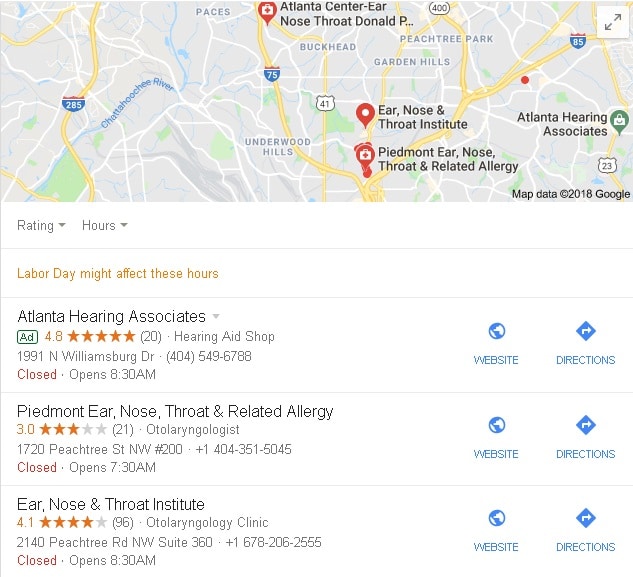Effective marketing is fundamental to the success of any business, and medical practices are absolutely no exception. However, utilizing digital marketing to boost a traditionally offline-focused company is something that’s often overlooked.
But why!?
After all, the people who matter to your business are inevitably hanging out online, whether that be conducting Internet searches, posting on social media and/or sending emails. That’s why no business today can ignore the importance of having an online presence – even medical practices!
To give you some food for thought, here are our top healthcare marketing tips for small practices:
Create a Professional-Looking Website
First and foremost, your small medical practice needs to have its own website – and a professional-looking one at that!
Your website will act as an extension of your physical practice and be a reflection of the excellent care you provide. It will also be at the very center of all your marketing efforts – both online (digital) and offline.
The good news is that a suitable website for your small medical practice will not (should not) cost the earth. In fact, there’s nothing to stop you starting out with a website that’s rather modest and improve/add to it in the future as you enhance your online offerings and adjust your marketing strategy going forward.
Optimize The User Experience
The next three points in this post all relate to your small practice’s website and they all feature the word ‘optimized’. Now don’t be put off by this often overused buzzword, it simply means enhanced/make better and, again, it doesn’t necessarily need to cost a small fortune.
Let’s start with user experience (UX) optimization.
In a nutshell, UX optimization is all about making sure your business website is intuitive, easy to navigate and does what a visitor expects. People should be able to find what they want in as short a time as possible and there should be enough information to successfully assist with their query.
Remember, your medical practice’s website will often be where potential customers first interact with your business. Make sure that initial interaction is a positive one and create a great first impression.
Here are just some of the ways you can improve your website’s UX:
- Intuitive menu system
- Easy to read fonts
- Obvious contact page/details
- Use a blend of text, images and video
- Add a search feature
- Use Alt Text tags for images
- Keep your visual branding consistent (logo, colours, etc.)
- Make sure your website is fast
Make Sure It’s Mobile-Friendly
This second point relating to optimization should really fall under the previous one, but because it’s so important nowadays I’ve chosen to give it its own subheading.
Now the reason mobile optimization is so damn important is simply because of the sheer number of people who default to browsing the Internet on their smartphones and tablets today.
How about this for a statistic: “In January 2025 mobile devices excluding tablets accounted for over 62 percent of web page views worldwide.” [source: Statista].
Being mobile-friendly is also a factor that’s playing an increasingly big role when it comes to search engine optimization (SEO). So not only could you be disappointing mobile visitors to your website by not making it mobile-friendly, you could also be affecting your search ranking at the same time. These two reasons alone highlight why a mobile-friendly website is an absolute must nowadays.
Nail Your Local SEO Efforts
Search engine optimization (SEO) is an important factor for boosting the fortunes of any website, but it can be especially beneficial for brick-and-mortar businesses that want to be seen by people in their local area – and that’s where local SEO comes in.
In a nutshell, local SEO is all about optimizing (there’s that word again) your website to rank better for local audiences, which is why local SEO makes such sense for medical practices.
At the end of the day, it’s going to be pretty unlikely that your business wants to target the entire online world. That’s because, quite simply, you’re going to get a much better ROI by connecting with people in your local area who are conducting searches for the services you offer.
Not sure about the power of local SEO? Check out this example:

I literally conducted a very quick Google search for the term “ear doctor Atlanta”. The results that were returned to me started off with three PPC ads (a little more on this later) followed by a bunch of local listings. These local listings appear higher than the number one result!
It’s no secret that Google loves local. It shouldn’t really come as a shock when you consider that every search engine’s goal is to provide a valuable, relevant and rewarding user experience. So if someone is searching for an ear doctor in Atlanta, it makes sense that Google wants to display actual medical practices first.
To get your local SEO efforts started, you need to claim your free Google My Business listing. Be careful when you enter all your details, as Google will actually verify your location by sending you a postcard through the mail.
Once verified, it’s just a case of adding all your relevant business information and making your listing shine.
Here are some pointers to get your Google My Business endeavors heading in the right direction:
- Customize your listing – While a default Google My Business page is probably still better than not having one, it doesn’t really shine you in the best light. Add your logo, some pictures of your staff, some pictures of your practice, and ensure all your business details are 100% correct.
- Tag your business correctly – It’s absolutely vital for SEO purposes that your business is tagged correctly. Carefully select the most appropriate business category and add some sub-categories, too.
- Don’t forget any unusual opening times – Does your business have different opening times throughout the year? Be sure to add any holiday opening times to ensure potential visitors get the best experience.
- Get some reviews – Social proof is an excellent way to build your reputation and show people how great the services you provide are. Consider asking your patients to review you on Google and social media (more on this later).
Feature a Blog for Effective Content Marketing
The best way to establish and maintain mutually beneficial relationships with your online audience is by engaging them with meaningful, informative and high-quality content. Many businesses achieve this by having a blog on their website and there’s absolutely no reason why your medical practice can’t, too!
One of the keys to running a successful blog – apart from simply creating high-quality content – is ensuring it is updated on a regular basis. This is especially applicable once you have drummed up a sizeable online following as people will often be expecting and even waiting for your new posts. Don’t let them down.
Now if you’re thinking, what kinds of content could I publish on a medical practice blog, the good news is that the possibilities are, quite literally, endless. Obviously, posts that focus on medical topics are the first that come to mind, but then there is content that relates to events, news, and happenings in your local area. These are great for posting your local SEO efforts and engaging with your community.
Have A Social Media Presence And Be Active
It’s almost a certainty that the people you want your medical practice to connect with are hanging out on social media somewhere.
Whether it’s Facebook, Twitter, Instagram, LinkedIn or one of the other popular social networks, there’s a good chance the people who would use the services your medical practice offers are active on at least one – and that’s why you should be, too!
As a very minimum you should create a business page/profile, try to increase your following by posting regularly, and encourage people to engage/interact with your business.
Consider using video (either pre-recorded or live) to reach more people and provide people with a genuine insight into your medical practice. Even things like short Q and A sessions with your staff can be very rewarding and spark conversations on social media, adding a definitive human element to your online marketing – a so-called face behind the brand.
Show Genuine Social Proof
Social proof is an extremely powerful tool that allows you to satisfy people’s natural follow-the-crowd tendencies. It highlights how great your business is by leveraging feedback from people who have used your services in the past.
Common examples of social proof are customer testimonials, Google reviews (on your Google My Business listing), social media reviews, case studies, and reviews on bespoke websites like Healthgrades.
Be proud of any good feedback you’ve received and prominently display it on your business website. Use any bad feedback to constructively shape your offerings going forward.
Unfortunately, the old adage of people being more likely to share bad experiences with businesses than good ones absolutely still applies in today’s Internet-first age. But instead of telling people in person, people today will shout about it on their social media profiles/leave you a bad review. That’s why even if your business is primarily offline, such as a medical practice, you still need to consider the online implications of providing a below-par service.
Creative Mindscape co-founder and CEO, Michele McDonough, published an awesome piece about social proof on Business 2 Community earlier this year. I highly recommend you check it out.
Utilize Email
While the people who take advantage of the services your medical practice offers will more than likely visit you in person or contact you via telephone, there’s no reason why you can’t try and encourage communication via email, too.
Even if it’s just for simple things like confirming an appointment, reminding someone about an upcoming appointment or telling people about minor changes, email is definitely a medium you can look to utilize.
As long as you do it legitimately and with people’s consent, there’s no reason why you can’t obtain the email addresses of the people who use your services.
A great way to reconnect with people who have previously used your services, but haven’t done so for a while is to conduct a ‘we miss you’ email campaign. Nothing too pushy, just a friendly reminder that you’re still for them if they need you.
Check out Creative Mindscape co-founder and COO, Neil Henry’s, brilliant post about email marketing on Business 2 Community.
Consider Using PPC Ads
In addition to all the good SEO work you’ll have done on your medical practice website, it’s also worth considering taking advantage of pay-per-click (PPC) ads on Google and/or social media platforms.
The beauty of PPC ads is that you are fully in control of your spending and can get your medical practice website in front of people using laser-targeted criteria. For example, you could pay to show ads for your medical practice to everyone in your local area over a certain age who searches for a particular keyword/keyphrase online, like “medical practice in X town”.
Remember, you only pay when someone clicks your ad, which is why a solid PPC campaign can really complement all your other digital initiatives.
Are you a small or medium medical practice that has found success online? We’d love to hear what you’ve been up to and how your digital marketing initiatives are bearing fruit.
Tweet us @JDevonshire
I’m a full-time freelance writer and Managing Editor at Creative Mindscape who is lucky enough to call the tropical paradise that is the Philippines my adopted home. In my spare time, I love to dabble in cryptocurrencies and play with my three young children. One’s a stressful, non-stop rollercoaster ride; the other is cryptocurrencies.




